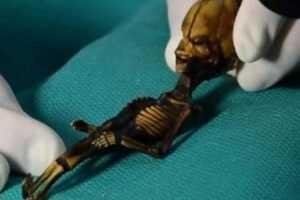A bizarre six-inch skeleton discovered in Chile's Atacama Desert belongs to a human foetus, and does not have extraterrestrial origins, scientists say. After five years of deep genomic analysis, researchers from the Stanford University and University of California, San Francisco (UCSF) in the US have pinpointed the mutations responsible for the anomalous specimen. They found mutations in not one but several genes known to govern bone development, researchers said.
The skeleton, nicknamed Ata, was discovered more than a decade ago in an abandoned town in the Atacama Desert of Chile. After trading hands and eventually finding a permanent home in Spain, the mummified specimen started to garner public attention. Standing just six inches tall with an angular, elongated skull and sunken, slanted eye sockets, the internet began to bubble with other-worldly hullabaloo and talk of ET, said Sanchita Bhattacharya from UCSF, the lead author of the study published in the journal Genome Research.
After sequencing Ata's genome, researchers found mutations in seven genes that separately or in combinations contribute to various bone deformities, facial malformations or skeletal dysplasia. The analysis pointed to a decisive conclusion: This was the skeleton of a human female, likely a foetus, that had suffered severe genetic mutations. Gary Nolan from Stanford saw that Ata, though most likely a foetus, had the bone composition of a six-year-old, an indication that she had a rare, bone-aging disorder.
To understand the genetic underpinnings of Ata's physicality, Nolan turned to Atul Butte from UCSF for help in genomic evaluation. “The phenotype, the symptoms and size of this girl were extremely unusual, and analysing these kinds of really puzzling, old samples teaches us better how to analyse the DNA of kids today under current conditions," he said. To understand the genetic drivers at play, Butte and Nolan extracted a small DNA sample from Ata's ribs and sequenced the entire genome. The skeleton is about 40 years old, so its DNA is modern and still relatively intact. Moreover, data collected from whole-genome sequencing showed that Ata's molecular composition aligned with that of a human genome. Nolan noted that 8 per cent of the DNA was unmatchable with human DNA, but that was due to a degraded sample, not extraterrestrial biology. Later, a more sophisticated analysis was able to match up to 98 per cent of the DNA, according to Nolan. 
Authors get paid when people like you upvote their post.
If you enjoyed what you read here, create your account today and start earning FREE STEEM!
If you enjoyed what you read here, create your account today and start earning FREE STEEM!
Hi! I am a robot. I just upvoted you! I found similar content that readers might be interested in:
http://med.stanford.edu/news/all-news/2018/03/mysterious-skeleton-shows-molecular-complexity-of-bone-diseases.html
Downvoting a post can decrease pending rewards and make it less visible. Common reasons:
Submit